Search results for: 'Stone to'
-
 Egyptian heart scarab
Egyptian heart scarabBig beetle stone from the Late Period of Ancient Egypt. Scarabs of this kind have been placed next to the heart on mummies. Nice mint green fayence.
Price: on request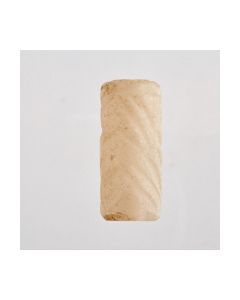 Mesopotamian cylinder seal with abstract scene
Mesopotamian cylinder seal with abstract sceneThe milky white stone is engraved with a scene that stands out by its high degree of abstraction. Late Uruk to Djemdet Nasr period, around 3000 BC.
Price: on request Large paleolithic hand axe
Large paleolithic hand axePrehistoric stone tool made of wonderfully banded stone. It was the universal tool of the older Stone age and could be used as a borer or a cutter. From a Swiss museum collection. Found in Morocco, North Africa.
Price: on request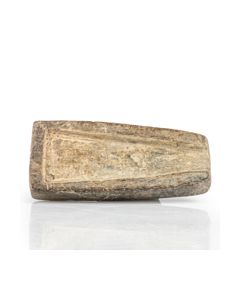 Bronze Age casting mould for a flat axe
Bronze Age casting mould for a flat axeOne half of a stone mould for bronze casting an axe head. The equipment is from a workshop of the 2nd Millennium BC, probably from the Carpathian Basin. From the famous Guttmann Collection. This mould was published in a work by Born and Hansen.
Price: on request Old Babylonian cylinder seal
Old Babylonian cylinder sealThis Old Babylonian seal with a worship scene is made from lapis lazuli, a very rare choice for this period.
Price: on request Early flat axe from Judea
Early flat axe from JudeaInteresting bronze axe head from Early Bronze Age. The piece was found in Judea.
Price: on request Early flat axe from Judea
Early flat axe from JudeaCompact bronze axe head from Early Bronze Age. The piece was found in Judea.
Price: on request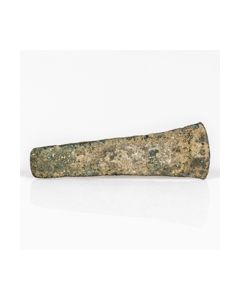 Early flat axe from Judea
Early flat axe from JudeaTrapezoidal axe head from Early Bronze Age. The piece was found in Judea.
Price: on request Cone-shaped stamp seal with star of Ishtar
Cone-shaped stamp seal with star of IshtarThe seal depicts a tree of life with a rhomb and eight-pointed star, symbol of Ishtar. 7th to 6th century BC.
Price: on request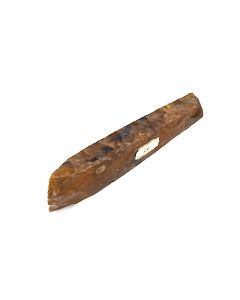 Neolithic axe head from Luetzow in Northern Germany
Neolithic axe head from Luetzow in Northern GermanyNice polished axe from brown flint. It was found more than 100 years ago near the town of Luetzow.
Price: on request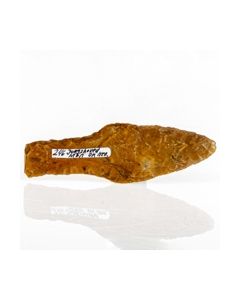 Scandinavian flint dagger
Scandinavian flint daggerNicely worked flint dagger from the transitional period between Late Neolithic and Early Bronze Age. Jungshoved on the Danish Island of Moen was the find spot.
Price: on request Sassanian intaglio with griffin
Sassanian intaglio with griffinPerfectly preserved ring stone made of orange carnelian. It shows a winged hybrid creature with the body of a lion. With inscription in Pahlavi, the Middle Persian script of the Sassanids.
Price: on request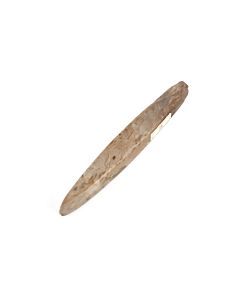 Neolithic chisel from Northern Germany
Neolithic chisel from Northern GermanyElegantly shaped chisel with two polished sides. Made of grey flint. Approx. 3400 to 2400 BC.
Price: on request Achaemenid stamp seal
Achaemenid stamp sealThis beautiful stamp seal is from the First Persian Empire of the Achaemenids or from parts under Greek control. 5th to 4th cent. BC.
Price: on request Neolithic dagger
Neolithic daggerNicely worked flint dagger of type III. Sprove on the Danish Island of Moen was the find spot. 1700 to 1500 BC.
Price: on request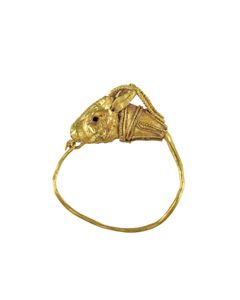 Hellenistic gold earring with antelope head
Hellenistic gold earring with antelope headEar pendant with plastically modeled head of an antelope. The elaborately made head is typical for hellenistic gold jewellery.
Price: on request Pair of early Byzantine gold earrings
Pair of early Byzantine gold earringsBeautiful jewellery with beads made of emerald and garnet. Made in the eastern part of the Mediterranean during the 6th to early 7th century.
Price: on request Two Mesopotamian mosaic cones
Two Mesopotamian mosaic conesThe pieces were part of a mosaic decoration of a Mesopotamian structure in the 4th Millenium BC. The temple architecture from Uruk is a particularly well known example of such a use.
Price: on request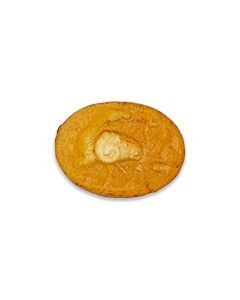 Roman intaglio with gryllos
Roman intaglio with gryllosThe hybrid creature was extremely popular during the Roman Empire. It was believed to convey magical powers.
Price: on request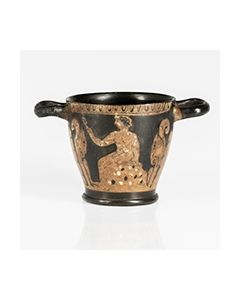 Very large Campanian red figure skyphos
Very large Campanian red figure skyphosDecorated with figures of youths, framed by palmettes. From an old German Frankonian collection. Acquired in the 1920s - 1930s.
Price: on request Mesopotamian stamp seal in bull shape
Mesopotamian stamp seal in bull shapeThe magnificent seal is from the Jemdet Nasr period. The stamp shows quadrupeds and a scorpion. Published in a book about the Epstein collection.
Price: on request Roman intaglio with the Spartan Othryades
Roman intaglio with the Spartan OthryadesThe glass paste depicts a scene from the battle of the 300. Othryades declares the victory of Sparta. He writes it on the shield of a slain enemy with blood from his own wounds.
Price: on request Neolithic axe head
Neolithic axe headNicely crafted Stone Age tool made of jadeite. From southern France.
Price: on request Paleolithic hand axe
Paleolithic hand axeSmall prehistoric stone tool. It was the universal tool of the older Stone age and could be used as a borer or a cutter. From a 100 year old museum collection.
Price: on request Paleolithic hand axe
Paleolithic hand axeSmall prehistoric stone tool. It was the universal tool of the older Stone age and could be used as a borer or a cutter. From a 100 year old museum collection.
Price: on request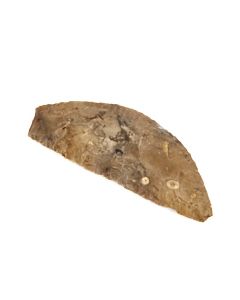 Neolithic sickle from Northern Germany
Neolithic sickle from Northern GermanySmall crescent-shaped blade made of beautiful grey flint. This tool represents an intermediate state within the radical transition from Neolithic to Bronze Age.
Price: on request Neolithic sickle from Northern Germany
Neolithic sickle from Northern GermanyCrescent-shaped blade made of beautiful grey flint. This tool represents an intermediate state within the radical transition from Neolithic to Bronze Age.
Price: on request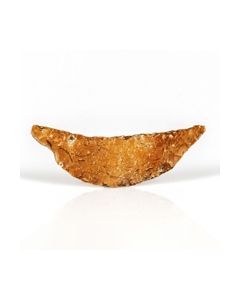 Small Neolithic sickle from Northern Germany
Small Neolithic sickle from Northern GermanyThe crescent-shaped blade is made of reddish brown flint. This tool represents an intermediate state within the radical transition from Neolithic to Bronze Age.
Price: on request Roman statue of a sitting man
Roman statue of a sitting manImpressive piece, possibly the funerary statue of a poet or a philosopher. From the collection of Prof. Ritschel, Salzburg, Austria, president of the local museum association, author of over 50 history books, decorated many times for his achievements.
Price: on request Large Apulian Pelike with thermoluminescence analysis
Large Apulian Pelike with thermoluminescence analysisDelicate piece of art, from an old German private collection. Acquired in the early 1980s in a Cologne art gallery.
Price: on request Hellenistic female head with melon coiffure
Hellenistic female head with melon coiffureAbout 5th century B.C. From an old collection of a Frech engineer.
Price: on request Flint blade and stone mould
Flint blade and stone mouldInteresting group of two artefacts. A Neolithic flint blade from Egypt and a Bronze Age mould for casting or hammering metal.
Price: on request Old Babylonian cylinder seal with gods and inscription
Old Babylonian cylinder seal with gods and inscriptionScene with sun god Shamash and the Amorite god Amurru. The cuneiform writing names the owner of the seal, a faithful servant of these deities.
Price: on request Small terracotta ushabti
Small terracotta ushabtiSimple funerary figurine from the 22nd to 25th dynasty of ancient Egypt. Part of a group of three figures that are said to be from the same grave.
Price: on request Ushabti of the 22nd dynasty
Ushabti of the 22nd dynastyRemarkable Egyptian funerary statuette made of green faience with black paint. Probably from Tanis and made during the 22nd dynasty.
Price: on request Small shabti
Small shabtiNice turquoise faience figurine with black paint. From the 22nd to 25th dynasty of ancient Egypt.
Price: on request

